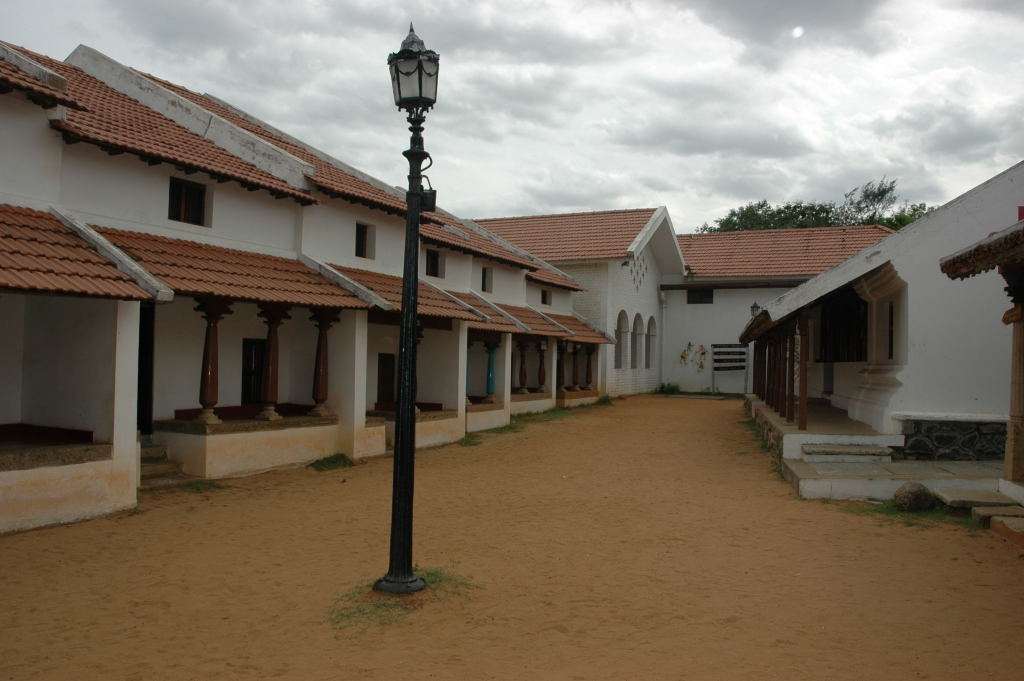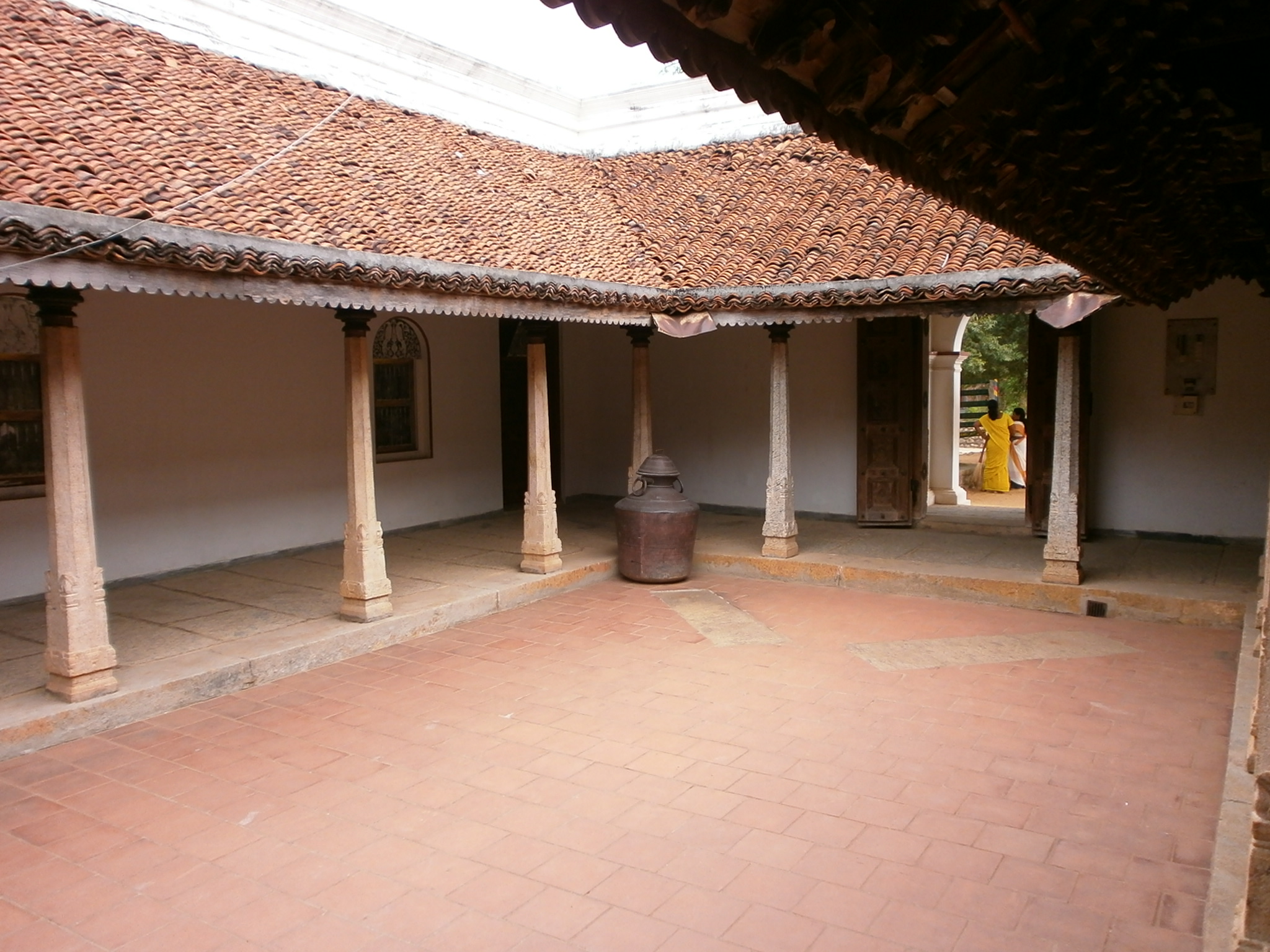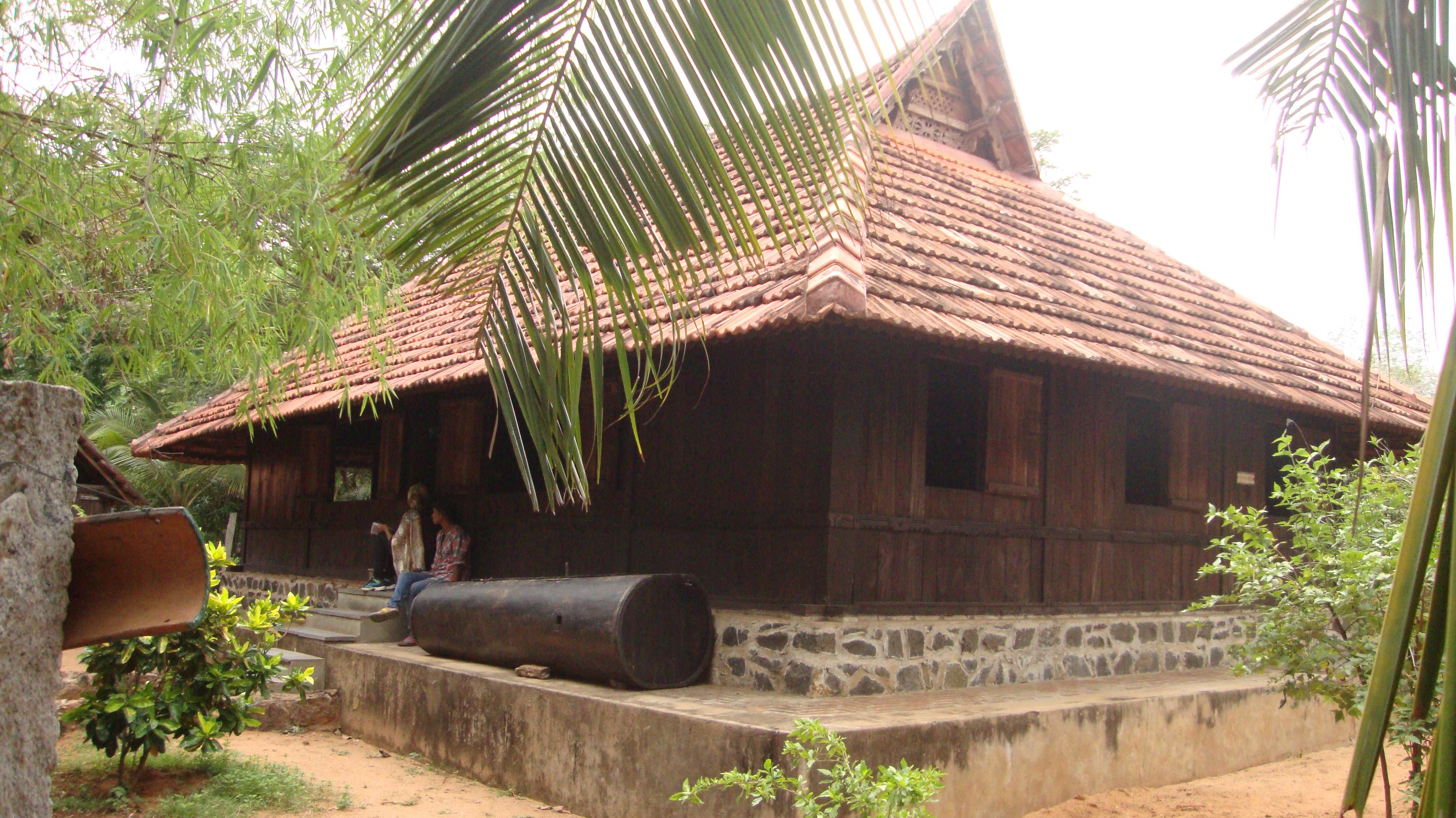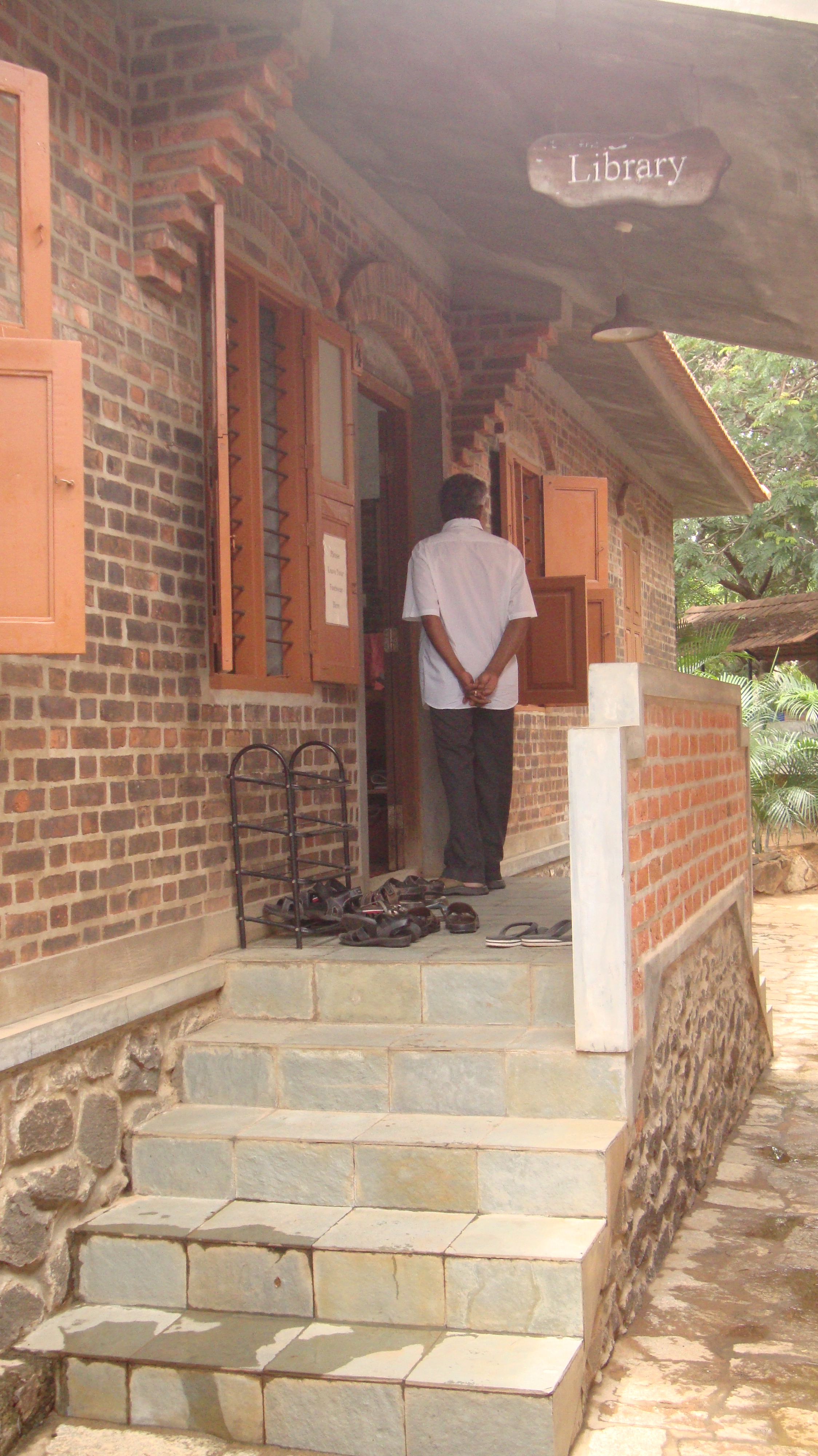DakshinaChitra on:
[Wikipedia]
[Google]
[Amazon]
DakshinaChitra ("a picture of the south") is a

 The complex brings together old buildings that have been transplanted from other sites, to give an idea of vernacular architecture and forms of community living from southern states namely Tamil Nadu, Andhra Pradesh,
The complex brings together old buildings that have been transplanted from other sites, to give an idea of vernacular architecture and forms of community living from southern states namely Tamil Nadu, Andhra Pradesh, 


 The collection consists of items of daily life used in the southern states. As of 2014, there were 4,220 artefacts on display; 3,200 are objects 950 are textiles and 70 contemporary works. The textile collection consists of cotton and silk attires of male (dhoti, lungi, kurta, turban, cap, ceremonial attire), female (saree, blouse, half saree, full skirt, set mundu, veil, scarf), furnishings, yardage (Real Madras Handkerchief, Ikat, Kalamkari etc. ), Telia Rumal, decorative wall hangings and ritual textiles. The entire display is in the
The collection consists of items of daily life used in the southern states. As of 2014, there were 4,220 artefacts on display; 3,200 are objects 950 are textiles and 70 contemporary works. The textile collection consists of cotton and silk attires of male (dhoti, lungi, kurta, turban, cap, ceremonial attire), female (saree, blouse, half saree, full skirt, set mundu, veil, scarf), furnishings, yardage (Real Madras Handkerchief, Ikat, Kalamkari etc. ), Telia Rumal, decorative wall hangings and ritual textiles. The entire display is in the
 DakshinaChitra has collection of over 14,000 books and journals on South Indian arts, crafts, performance, anthropology and folklore. The Library includes the National Folklore Support Centre's collections and also houses more than 1,00,000 photographs and a vast collection of DVDs, CDs and tapes. Some of the archives are of old journal collections such as Marg, India Magazine, Lalit Kala, Sangeet Natak as well as other journal collections such as South Asian Studies, Art India etc. They also have census reports on crafts, houses, festival and out-of-print books on crafts and arts. DakshinaChitra accepts donation of books related to art, craft and culture of South India.
DakshinaChitra has collection of over 14,000 books and journals on South Indian arts, crafts, performance, anthropology and folklore. The Library includes the National Folklore Support Centre's collections and also houses more than 1,00,000 photographs and a vast collection of DVDs, CDs and tapes. Some of the archives are of old journal collections such as Marg, India Magazine, Lalit Kala, Sangeet Natak as well as other journal collections such as South Asian Studies, Art India etc. They also have census reports on crafts, houses, festival and out-of-print books on crafts and arts. DakshinaChitra accepts donation of books related to art, craft and culture of South India.
 The museum is a center for living traditions of art, folk performing arts, and crafts set up with the objective of preserving and promoting South India's heritage and culture. Special programmes feature dances, crafting of necklaces, basket weaving, and puppet shows. The museum also holds workshops for training in traditional crafts such as
The museum is a center for living traditions of art, folk performing arts, and crafts set up with the objective of preserving and promoting South India's heritage and culture. Special programmes feature dances, crafting of necklaces, basket weaving, and puppet shows. The museum also holds workshops for training in traditional crafts such as
living-history museum
An open-air museum (or open air museum) is a museum that exhibits collections of buildings and artifacts out-of-doors. It is also frequently known as a museum of buildings or a folk museum.
Definition
Open air is “the unconfined atmosphere†...
in the Indian state
India is a federal union comprising 28 states and 8 union territories, with a total of 36 entities. The states and union territories are further subdivided into districts and smaller administrative divisions.
History
Pre-indepen ...
of Tamil Nadu
Tamil Nadu (; , TN) is a state in southern India. It is the tenth largest Indian state by area and the sixth largest by population. Its capital and largest city is Chennai. Tamil Nadu is the home of the Tamil people, whose Tamil language ...
, dedicated to South Indian heritage and culture. It is located to the south of Chennai
Chennai (, ), formerly known as Madras ( the official name until 1996), is the capital city of Tamil Nadu, the southernmost Indian state. The largest city of the state in area and population, Chennai is located on the Coromandel Coast of th ...
. Opened to the public on 14 December 1996, the museum
A museum ( ; plural museums or, rarely, musea) is a building or institution that cares for and displays a collection of artifacts and other objects of artistic, cultural, historical, or scientific importance. Many public museums make th ...
was founded and is being managed by the Madras Craft Foundation (MCF). The MCF was established in 1984. Deborah Thiagarajan, an Indian art historian of American origin, governs the museum
A museum ( ; plural museums or, rarely, musea) is a building or institution that cares for and displays a collection of artifacts and other objects of artistic, cultural, historical, or scientific importance. Many public museums make th ...
. The museum
A museum ( ; plural museums or, rarely, musea) is a building or institution that cares for and displays a collection of artifacts and other objects of artistic, cultural, historical, or scientific importance. Many public museums make th ...
is built on of land taken on a 33-year lease from the Government of Tamil Nadu
Government of Tamil Nadu is the subnational government for the Indian state of Tamil Nadu. It is seated at Fort St George, Chennai. The legislature of Tamil Nadu was bicameral until 1986, when it was replaced by a unicameral legislature ...
. Located at Muttukadu, on the East Coast Road
East Coast Road (ECR), combination of SH-49, NH-332A, NH-32, officially known as Mutthamizh Arignar Kalaignar Road, is a two-lane highway (now being partially upgraded to four-lane way from Chennai to Mamallapuram) in Tamil Nadu, India, bu ...
connecting Chennai and Pondicherry, the site overlooks Bay of Bengal
The Bay of Bengal is the northeastern part of the Indian Ocean, bounded on the west and northwest by India, on the north by Bangladesh, and on the east by Myanmar and the Andaman and Nicobar Islands of India. Its southern limit is a line bet ...
.
Developed as a heritage village, DakshinaChitra has an array of displays and relocated originals of dwellings
In law, a dwelling (also known as a residence or an abode) is a self-contained unit of accommodation used by one or more households as a home - such as a house, apartment, mobile home, houseboat, vehicle, or other "substantial" structure. Th ...
depicting the life pattern of people in the states of southern India
South India, also known as Dakshina Bharata or Peninsular India, consists of the peninsular southern part of India. It encompasses the Indian states of Andhra Pradesh, Karnataka, Kerala, Tamil Nadu, and Telangana, as well as the union territ ...
. The exhibits portray the architecture
Architecture is the art and technique of designing and building, as distinguished from the skills associated with construction. It is both the process and the product of sketching, conceiving, planning, designing, and constructing buildings ...
, art, folk performing-arts and craft of South Indian traditions. The amenities include a research unit, crafts bazaar, playground, an area to hold religious functions, stone workshop, and souvenir kiosks. There are craftsmen who permanently work at DakshinaChitra who demonstrate or explain how they make their wares. Besides workshops are conducted regularly for various crafts by artists who rent the community studio.
History
DakshinaChitra, meaning "a picture of the south", is a heritage village where the lifestyle ofSouth Indians
The Dravidian peoples, or Dravidians, are an ethnolinguistic and cultural group living in South Asia who predominantly speak any of the Dravidian languages. There are around 250 million native speakers of Dravidian languages. Dravidian spe ...
is displayed based on their states, through the architecture
Architecture is the art and technique of designing and building, as distinguished from the skills associated with construction. It is both the process and the product of sketching, conceiving, planning, designing, and constructing buildings ...
of the region and the living conditions and habits of the people. It was founded by the Madras Craft Foundation (MCF), an NGO
A non-governmental organization (NGO) or non-governmental organisation (see spelling differences) is an organization that generally is formed independent from government. They are typically nonprofit entities, and many of them are active in h ...
started in 1984, by Deborah Thiagarajan. Thiagarajan came to Madras (now Chennai
Chennai (, ), formerly known as Madras ( the official name until 1996), is the capital city of Tamil Nadu, the southernmost Indian state. The largest city of the state in area and population, Chennai is located on the Coromandel Coast of th ...
) in 1970, and visited several rural villages in Tamil Nadu and Kerala
Kerala ( ; ) is a state on the Malabar Coast of India. It was formed on 1 November 1956, following the passage of the States Reorganisation Act, by combining Malayalam-speaking regions of the erstwhile regions of Cochin, Malabar, South Ca ...
. She founded MCF in 1984 with the intent of preserving the regional culture and heritage. In July 1991, the MCF received of land for the project from the Government of Tamil Nadu
Government of Tamil Nadu is the subnational government for the Indian state of Tamil Nadu. It is seated at Fort St George, Chennai. The legislature of Tamil Nadu was bicameral until 1986, when it was replaced by a unicameral legislature ...
on a 33-year lease. In establishing the museum, cooperation was maintained between government organizations, industry and specialists in the sphere of conservation. Contributors to the museum's creation included long-term corporate donors ord Foundationand the Office of the Development Commissioner for Handicrafts .
The roots of this museum can be traced back to the open-air museums of Europe, the United States, Japan and Southeast Asia, though its closest precursor is National Handicrafts and Handlooms Museum, New Delhi
The National Handicrafts and Handlooms Museum (NHHM) commonly known as National Crafts Museum in New Delhi is one of the largest crafts museums in India. It is run by the Ministry of Textiles, Government of India. The museum is situated on the ...
. Deborah Thiagarajan was influenced by Old Sturbridge Village and Plimoth Plantation
Plimoth Patuxet is a complex of living history museums in Plymouth, Massachusetts, founded in 1947. Formerly Plimoth Plantation, it replicates the original settlement of the Plymouth Colony established in the 17th century by the English coloni ...
(USA) and unidentified sites in Japan and Romania. The center's emphasis on pre-industrial technology and material culture
Material culture is the aspect of social reality grounded in the objects and architecture that surround people. It includes the usage, consumption, creation, and trade of objects as well as the behaviors, norms, and rituals that the objects crea ...
were selectively borrowed from many of the existing museums. DakshinaChitra's exhibitions are predominantly architectural as at Skansen, Greenfield Village (USA) and the Weald and Downland Museum (England). The exhibitions consist of relocated originals. Not all structures are reassembled originals, as seen at Colonial Williamsberg and Plimoth Plantation
Plimoth Patuxet is a complex of living history museums in Plymouth, Massachusetts, founded in 1947. Formerly Plimoth Plantation, it replicates the original settlement of the Plymouth Colony established in the 17th century by the English coloni ...
, several structures are generic replicas of vernacular styles and others are exact recreations of specific off-site structures. In addition, the exhibitions span a broad range. With its relocated originals and re-created copes, DakshinaChitra aims to represent the late-eighteenth to mid-twentieth century, framing that vaguely bounded period of intensive British colonization''.'' 
Design
The museum's master plan was developed byarchitect
An architect is a person who plans, designs and oversees the construction of buildings. To practice architecture means to provide services in connection with the design of buildings and the space within the site surrounding the buildings that h ...
Laurie Baker, free of cost, because of his interest in rural architectural design. A master plan is a small-scale graphic outline that shows all the major elements of a project. Laurie Baker, known for his unconventional approach, included the use of local materials and the adaptation of artisanal production methods suited to the environment in design. Baker began his master plan for DakhshinaChitra as a map, which in execution on site was different from the it. He planned to represent architecture
Architecture is the art and technique of designing and building, as distinguished from the skills associated with construction. It is both the process and the product of sketching, conceiving, planning, designing, and constructing buildings ...
of each southern state as a village with its small streets and walkways. Baker did not want to have grand buildings in the campus. He thought that ‘this place’ should deal with arts and crafts of ordinary people. He pursued his philosophy of ‘small is beautiful’. Benny Kuriakose
Benny Kuriakose (born 25 May 1962) was born in Kerala, India. He made his mark in architectural conservation and the design of new buildings, taking his roots from the vernacular architecture of South India. He is known for designing structures w ...
, the architect who carried out the work later, recalls in one of his articles that Baker said; “the idea is to abandon the big exhibition pavilion system entirely. For one thing, they can’t be typical or genuine because our forebears didn’t have such things, and for another thing, folk stuff is mainly small. Blow it up and out of size, it is all wrong.”
Kuriakose, retained the main "spatial types and syntax", but altered the layout of master plan. The reason for this change was due to change in circumstances around the site location. One such example is the change of entrance from side road to the East Coast Road
East Coast Road (ECR), combination of SH-49, NH-332A, NH-32, officially known as Mutthamizh Arignar Kalaignar Road, is a two-lane highway (now being partially upgraded to four-lane way from Chennai to Mamallapuram) in Tamil Nadu, India, bu ...
. When Baker prepared the master plan, the sizes and styles of the buildings which are purchased were not known. To accommodate these transplanted buildings, master plan had to be modified. Although Kuriakose's association with Baker and Thiagarajan started in 1984, with MCF, he became involved with buildings in DakshinaChitra only in the second half of 1995, with the construction of the three houses in Kerala section- Calicut
Kozhikode (), also known in English as Calicut, is a city along the Malabar Coast in the state of Kerala in India. It has a corporation limit population of 609,224 and a metropolitan population of more than 2 million, making it the second ...
house, Puthupally house and Koothattukulam
Koothattukulam is a town and municipality situated in Muvattupuzha taluk, towards the south east corner of Ernakulam district in Kerala State, India. It lies at the junction of three districts: Ernakulam, Kottayam and Idukki, and cove ...
house. Later, they designed the main reception center, the stores, the gallery, the restaurant, guesthouses 2 and 3, and the other minor public buildings.Collection
Architecture

 The complex brings together old buildings that have been transplanted from other sites, to give an idea of vernacular architecture and forms of community living from southern states namely Tamil Nadu, Andhra Pradesh,
The complex brings together old buildings that have been transplanted from other sites, to give an idea of vernacular architecture and forms of community living from southern states namely Tamil Nadu, Andhra Pradesh, Karnataka
Karnataka (; ISO 15919, ISO: , , also known as Karunāḍu) is a States and union territories of India, state in the southwestern region of India. It was Unification of Karnataka, formed on 1 November 1956, with the passage of the States Reor ...
and Kerala
Kerala ( ; ) is a state on the Malabar Coast of India. It was formed on 1 November 1956, following the passage of the States Reorganisation Act, by combining Malayalam-speaking regions of the erstwhile regions of Cochin, Malabar, South Ca ...
. It has zones devoted to these four southern states. The architecture is not grandiose, and is not folk either, this is mostly urban middle class traditional architecture, which means it is a complex that eschews spectacle and grand scale, as well as ethnography.
The museum has 18 heritage houses representing the living styles of people from the states. The original houses in their "vernacular style" were purchased by MCF and were recreated by a team of masons, carpenters
Carpentry is a skilled trade and a craft in which the primary work performed is the cutting, shaping and installation of building materials during the construction of buildings, ships, timber bridges, concrete formwork, etc. Carpenters t ...
and architecture students. The purchase costs varied from Rs. 50,000 for ordinary mud houses to Rs. 1.5 million for the Chettinad
Chettinad (also known as Chettinadu) is a region located mainly in the Sivaganga district historically ruled by Ramnad kingdom of Pandya Nadu and has a small portion extending into the Pudukottai District in Tamil Nadu, India..Karaikudi and ...
merchants' mansions with crafted doors and woodwork. They were then dismantled systematically under the guidance of ''stapathis'' (temple architects). The dismantled elements were transported to the museum site and recreated at the allotted space in their exact original form. Apart from recreating the homes, the roads and all other features that existed in the old village sites were recreated.
Tamil Nadu section showcases how yesteryear merchants, Brahmins, silk weavers, agriculturists and potters lived. The Ikat weavers house and coastal Andhra house are exhibited in Andhra Pradesh section. The Ilkal weavers house and a house from Chikamagalur are at display in Karnataka section. In the Kerala section, the Syrian Christian house known for its distinctive layout with the entrance leading directly to the granary, the Hindu house built largely using jackfruit wood and palmyra and the Calicut house representing homes in north Kerala are displayed.

Artefacts
English language
English is a West Germanic language of the Indo-European language family, with its earliest forms spoken by the inhabitants of early medieval England. It is named after the Angles, one of the ancient Germanic peoples that migrated to the ...
, and highlights the cultural aspects of people and the craft traditions of heritage homes of South India.
Library and Archives
 DakshinaChitra has collection of over 14,000 books and journals on South Indian arts, crafts, performance, anthropology and folklore. The Library includes the National Folklore Support Centre's collections and also houses more than 1,00,000 photographs and a vast collection of DVDs, CDs and tapes. Some of the archives are of old journal collections such as Marg, India Magazine, Lalit Kala, Sangeet Natak as well as other journal collections such as South Asian Studies, Art India etc. They also have census reports on crafts, houses, festival and out-of-print books on crafts and arts. DakshinaChitra accepts donation of books related to art, craft and culture of South India.
DakshinaChitra has collection of over 14,000 books and journals on South Indian arts, crafts, performance, anthropology and folklore. The Library includes the National Folklore Support Centre's collections and also houses more than 1,00,000 photographs and a vast collection of DVDs, CDs and tapes. Some of the archives are of old journal collections such as Marg, India Magazine, Lalit Kala, Sangeet Natak as well as other journal collections such as South Asian Studies, Art India etc. They also have census reports on crafts, houses, festival and out-of-print books on crafts and arts. DakshinaChitra accepts donation of books related to art, craft and culture of South India.
Programs
indigo
Indigo is a deep color close to the color wheel blue (a primary color in the RGB color space), as well as to some variants of ultramarine, based on the ancient dye of the same name. The word "indigo" comes from the Latin word ''indicum'', ...
dying. Potters trained at the center are issued a certificate of their skills by the regional office of the Department of the Development Commissioner (Handicrafts). Classical dances such as Bharatnatyam
Bharatanatyam () is a major form of Indian classical dance that originated in Tamil Nadu. It is one of the eight widely recognized Indian classical dance forms, and expresses South Indian religious themes and spiritual ideas, particularly of ...
, Mohiniyattam
Mohiniyattam, ( ml, മോഹിനിയാട്ടം), is an Indian classical dance form that developed and remained popular in the state of Kerala. Kathakali is another classical dance form of Kerala. Mohiniyattam dance gets its name fr ...
and Kuchipudi
Kuchipudi () ( Telugu: ) is one of the eight major Indian classical dances. It originates from a village named Kuchipudi in the Indian state of Andhra Pradesh.
Kuchipudi is a dance-drama performance, with its roots in the ancient Hindu Sa ...
, and music concerts are regular events held in the large amphitheater. Each year, 15,000 school children visit the museum.Criticism
Anthropologist and historian, Mary Hancock has written about DakshinaChitra in her book ''The Politics of Heritage from Madras to Chennai.'' She has written that the global template of DakshinaChitra has earned both praise and criticism, with some conservation architects and cultural tourism proponents describing it as a Disneyfied version of south India's past; some critics complaining that the characterization of pre-industrial village life is inaccurate, focusing too much on the Nattukkottai Chettiar, and that the site is "stamped" with "American consumerism". With its fusion of the education, entertainment and spectacle, it is a major destination marketed to the cosmopolitan audiences. It is a space offering rural southern India as representation of the country, that invites both detached contemplation and nostalgic attachment. It is also said that DakshinaChitra embodies the contradiction of mourning the loss of pre- industrial life ways, yet is premised on free-market economic practice. But the curator, Thiagarajan traces her commitment to the project to deeply felt concerns about the loss of vernacular architectural, performance and craft traditions with southern India's rapid industrialization.References
Bibliography
* * * * * * *External links
* {{Portal, India Villages in Chengalpattu district Tourist attractions in Chennai Culture of Chennai Cultural centres in Chennai Living museums